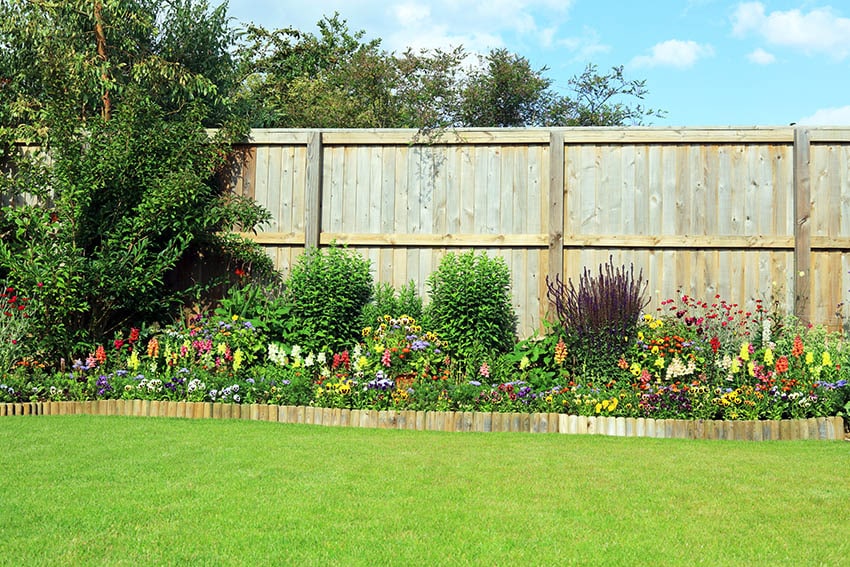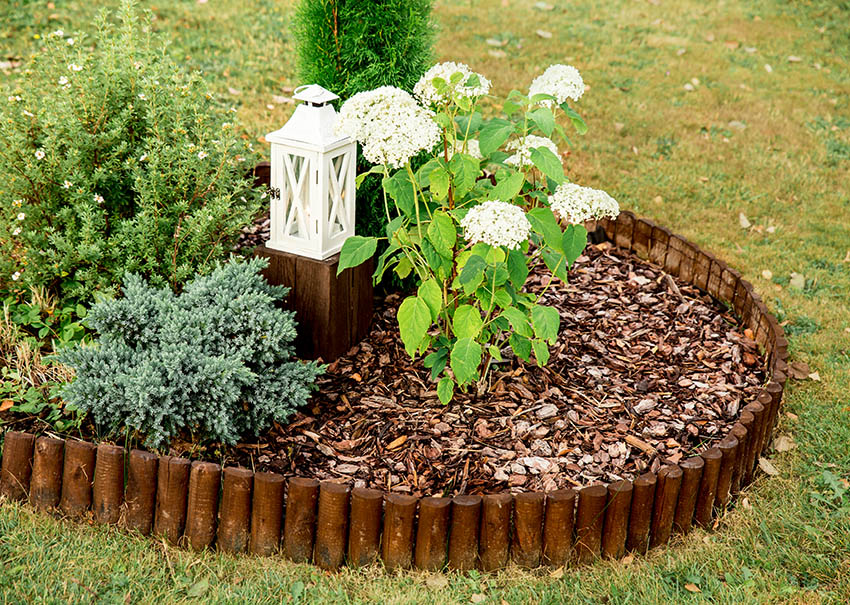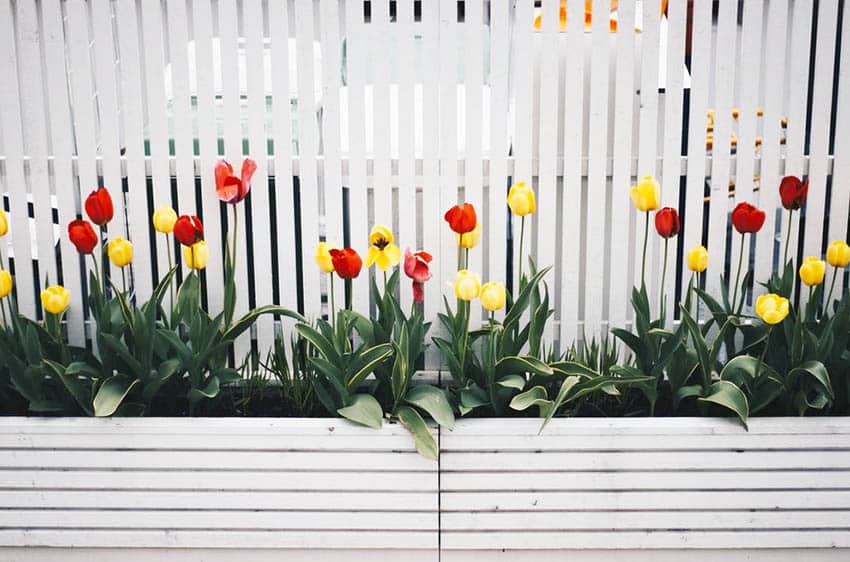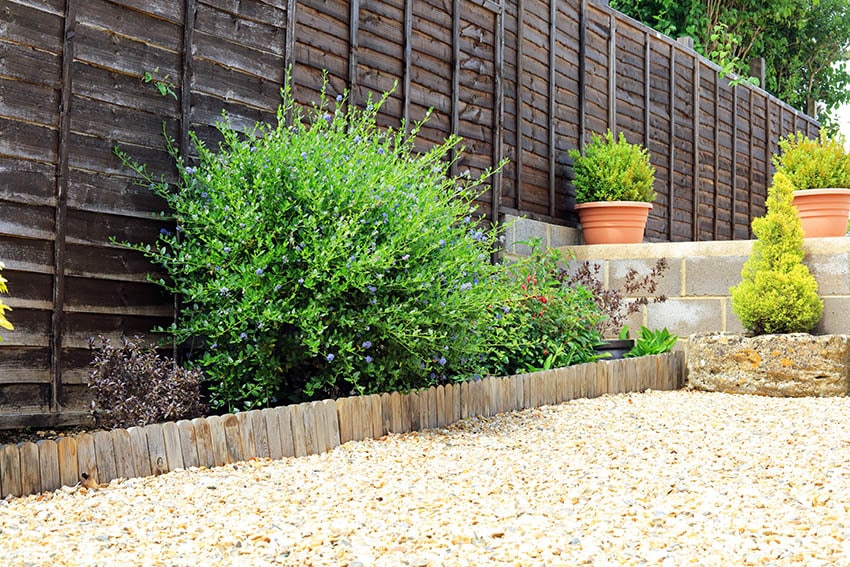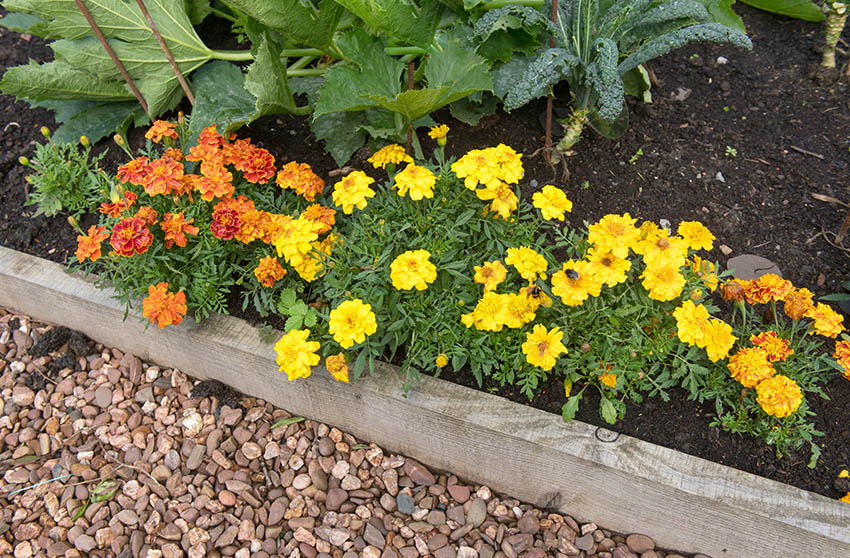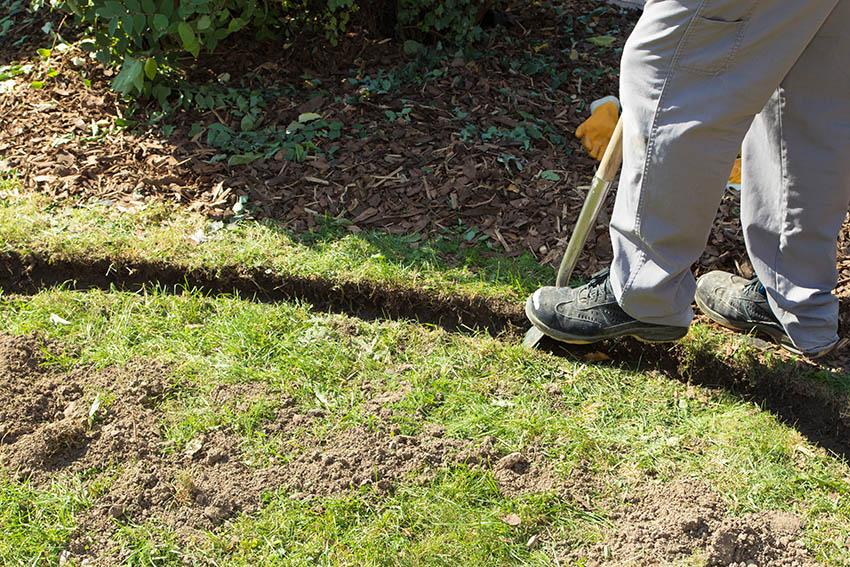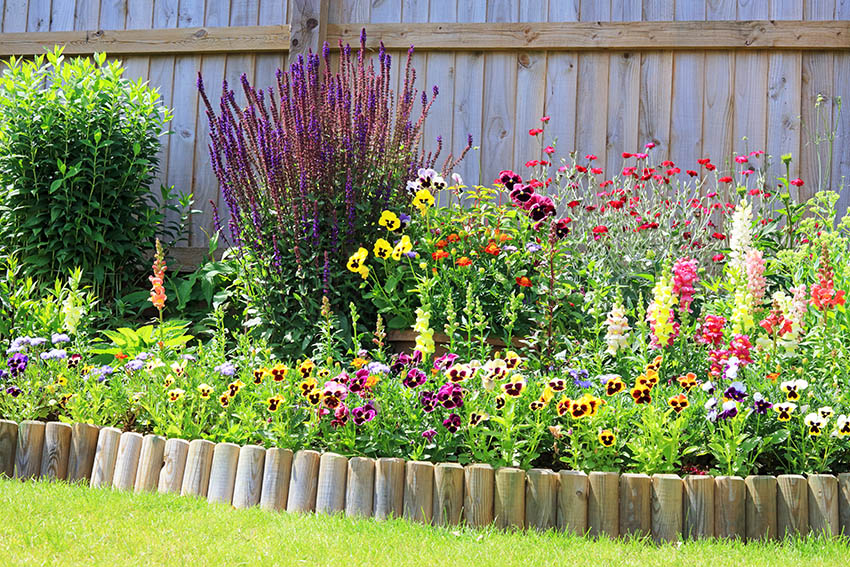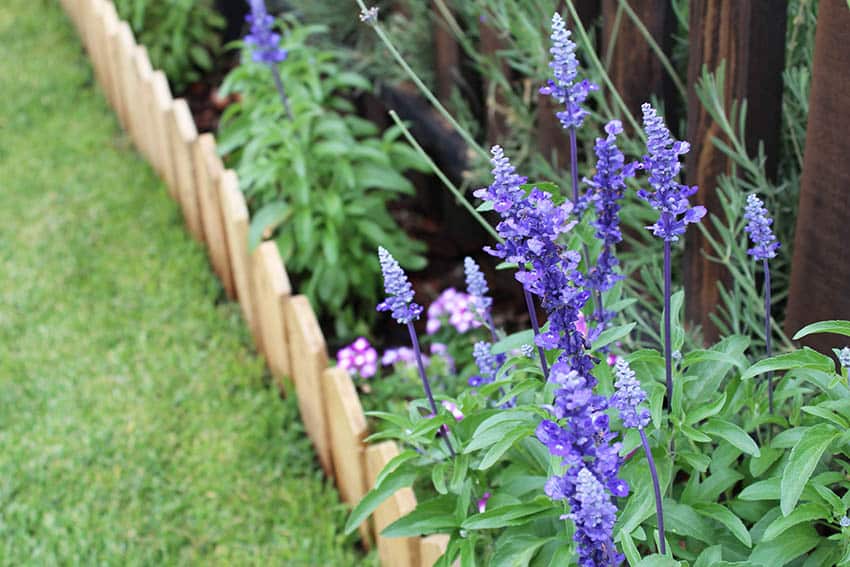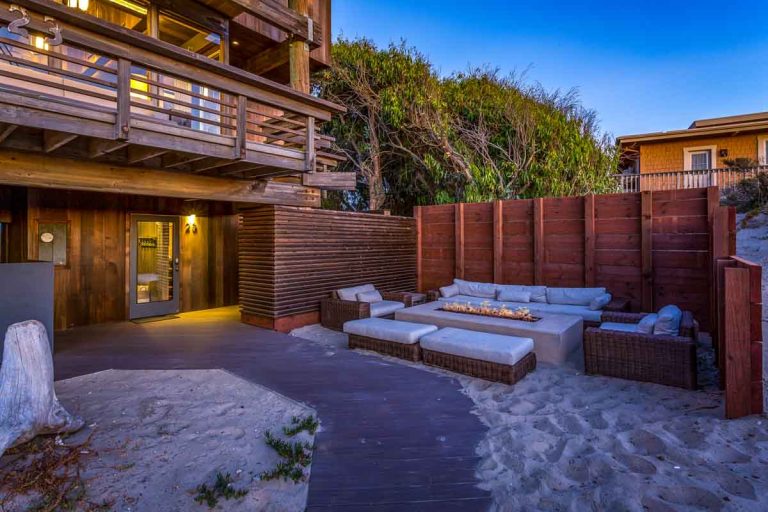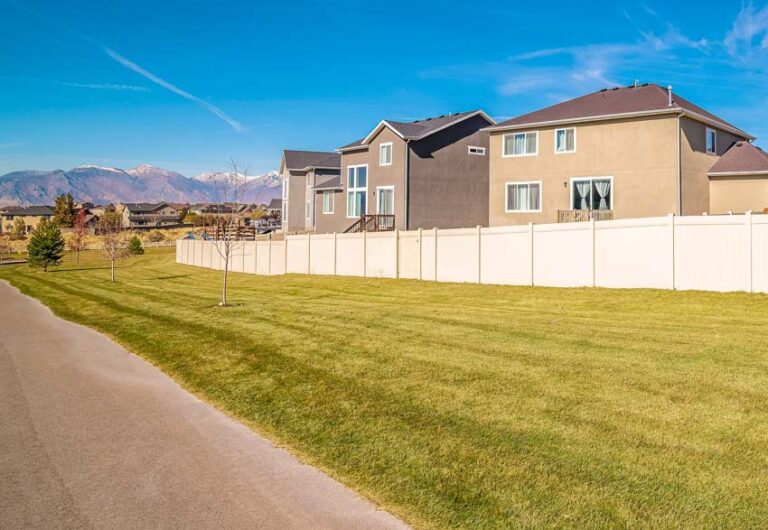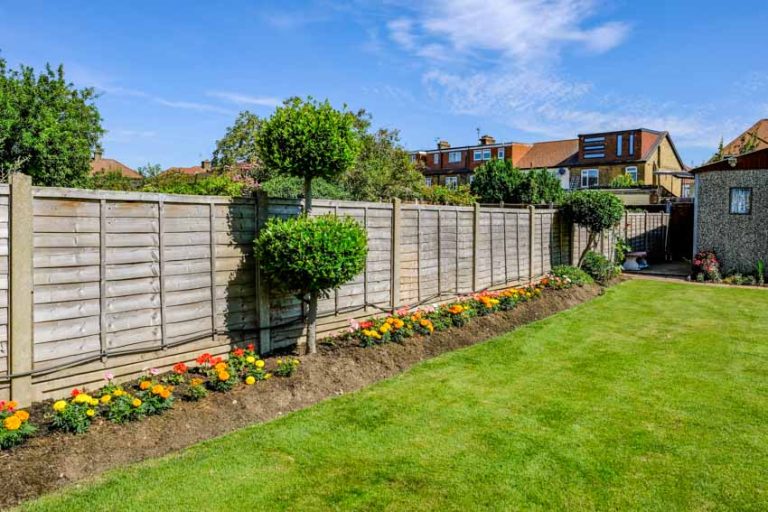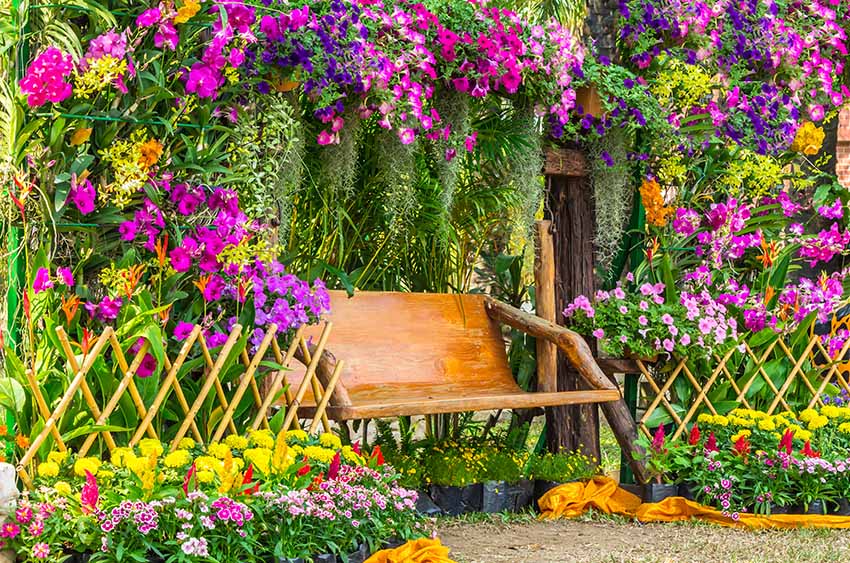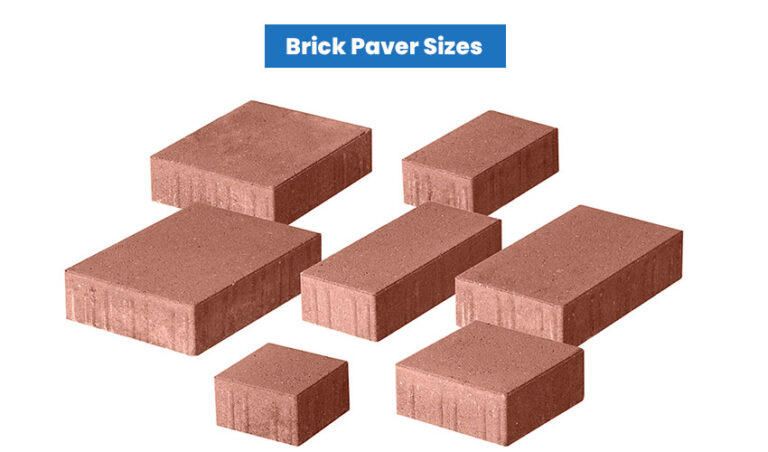Wooden Garden Edging (11 Landscaping Design Ideas)
Here’s our wooden garden edging guide, including what it is, different types, cost, and landscaping design ideas.
If your garden is lacking definition, poor edging may be to blame. Without borders of some kind, it’s only a matter of time before gravel migrates onto the lawn and grass starts growing between the stone path you just laid.
Edging is the gardener’s term for any solution to the problem of material migration. While plastic, brick, and cement options are available, one of the most popular materials for edges in gardens is wood.
What is Wooden Landscape Edging?
Wooden garden edging is a barrier constructed between two areas to add separation. It can line pathways, hold mulch in place, or form planting beds. The material used to construct wooden garden border edges is called landscaping timber.
Typically, multiple pieces of landscaping timber are laid in a trench around the path, bed, or landscaping feature. They are connected at the corners using braces, forming a frame. The trench is then filled in, leaving only the top of the landscaping timber uncovered.
Because the wooden edging is partially buried underground, it is in near-constant contact with moisture. Untreated wood absorbs water and microbes from the soil around it.
Before long, rot takes hold. The landscaping timbers must be removed and replaced within two or three years. Treated wood, conversely, can hold up to moisture exposure for much longer — up to seven or even ten years.
Note that ‘treated’ is not the same as ‘finished’. Applying a protective coat of stain or sealant to the wood can help form a barrier that protects the exterior of the wood but does not penetrate to the center of the beam.
Treated wood has had chemicals applied that serve a specific purpose and change the qualities of the timber. Consumers often choose composite wood to edge their gardens for the look of wood with the durability of plastic.
This article explains the differences between wooden edging options and shares some of the most popular design ideas. It also covers the cost of installing wooden borders and includes tips and tricks on how to do it yourself.
Wooden Garden Edging Ideas
The quickest and easiest wooden garden edging technique uses long beams, laid horizontally in the trench. Install a single, thin piece of landscape timber to provide a low-profile barrier between a flower bed and lawn. Or, choose a wider and thicker beam for a more substantial look.
Wooden garden edging can even speed up your lawn care routine. An edge border of sufficient thickness provides a margin of error when using mowers or trimmers, so you can work more quickly while still keeping your flower beds safe.
Other ideas for edging include stacking several landscaping logs on top of each other to form a log wall or laying square-cut beams in an interlocking pattern for a farmhouse feel.
Landscaping timber can also be cut into smaller pieces and laid vertically. Varying the height of the pieces creates an interesting and whimsical fence effect. Thick wooden blocks that are all the same height can convey a more staid and formal tone.
You can even paint, stain, or even carve the beams used to form your border edges to customize your flower beds and walkways fully. See more garden fence ideas on this page.
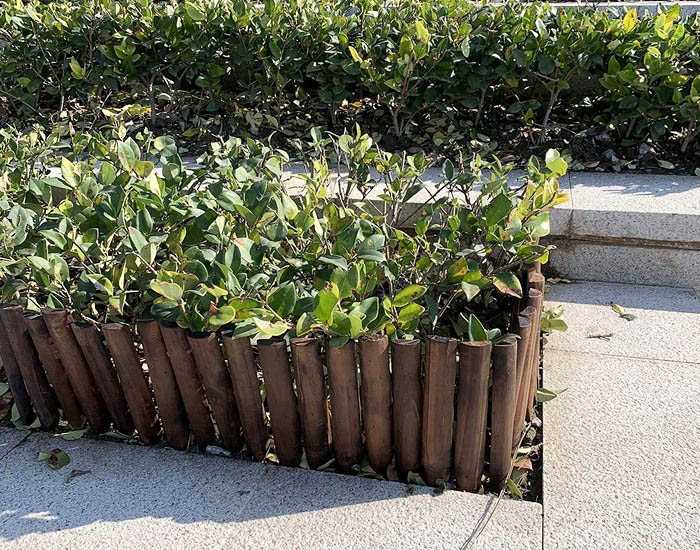
Rolls of small wooden garden fencing can be purchased with stakes for easier installation.
Garden fence planter with horizontal wood flower box.
Pressure Treated Wood Edging
Pressure treated wood edge border is usually treated with preservatives that help the timber resist mildew, fungi, and pests such as termites.
Some treated wood is also protected with flame retardant chemicals. Certain processes can even prepare treated wood for use in a marine environment, but this is not necessary for landscaping timber.
You may be concerned about the presence of chemicals in the wood. CCA, or copper chromated arsenate treated wood was found to cause significant health problems, especially in children, and is no longer rated for use in residential environments. CA (copper azole) or ACQ (Alkaline Copper Quaternary) treated lumber is used instead.
A rating system is used to indicate the appropriate use for a given piece of treated lumber. This is on a tag at the edge of the board or beam. For landscaping purposes, the timber must be rated for ground contact.
The code for this rating is ‘UC4’. UC4A refers to timber suitable for ‘general use’, while UC4B would denote the timber is rated for ‘heavy-duty use’. Either is acceptable for use in wooden edges, per Forest Products Lab.
The biggest concern most people have when it comes to pressure treated wood is preventing the chemicals from leaching into the air and soil around them. This is especially important for homes with children or pets, or where plants are grown for food.
ACQ treated lumber may release small amounts of copper into the soil over time, but is considered to be low-risk to human health, even when used to edge vegetable gardens.
Composite Wood Edging

Made mostly of plastic, but with realistic wood-like features, composite border edge is sold in strips or rolls. It is less expensive than natural materials and lasts significantly longer.
Newer composite products have improved on the appearance and texture of older models. Many now include features like raised imitation wood grain.
A v-shaped trench is used when installing composite wood edges, because the material is quite thin and won’t balance on its edge. This cost-effective option makes it easy to execute curved designs, due to its bendability.
Timber Edging
Timber garden edging is made from natural wood cut into planks or beams. The boards used to create timber edge may be treated or untreated.
Thin, wide boards are used to create clean and crisp borders around mulched or raised garden beds. Landscaping timber can have a square or rounded profile. It may even be milled into a cylindrical log.
When border is required to follow the curve of a flower bed or walkway, thin ‘bender boards’ can be soaked in water and formed into curvilinear timber edges.
DIY Wood Border Edging
If you want to install lumberedging yourself, you have a variety of choices to make. Luckily, all the supplies you will need can be purchased at a lumber yard or home improvement center. This project can easily be completed by even a novice DIYer.
First, select a material. Will you be using natural or synthetic wood? If you use natural wood, will it be treated or untreated?
Next, determine how wide you want your edge to be. Wider border can make trimming or mowing the grass easier without risking your flowers or vegetables.
A narrower wooden edge can be combined with bender boards to form delicate and curved borders along a garden path, but this is a more advanced technique.
Dig a trench in the ground slightly wider than the edge you insert. Make sure the bottom of the trench is level.
The depth of the trench depends on the purpose of the edging. For mulch, it is recommended that the edge be at least six inches high, with four inches underground and two inches above ground. For borders around gravel or stone paths, the top of the wooden edging should be ⅛ of an inch above ground level or less.
Place the beams in the trench, using mender plates to connect shorter beams. Where two beams form a corner, use a corner brace to connect them. Fill in the trench and tamp down the soil.
Wooden Edging Board Cost
The wooden garden edging material determines how long it will last and how often it needs to be replaced. It would be misleading to compare a product that lasts 20 years with one that may start to decay after 20 months.
An average-sized garden bed is 4×8 feet, requiring 24 feet of edging material to form a suitable frame. This amount of untreated timber can be sourced for around $150.
Treated landscaping timber would be slightly more expensive, costing $200 to cover the same area.
Synthetic or composite wood is less expensive, averaging $75 for the material to edge a typical planter bed of this size.
Composite wood can last up to twenty years before needing replacement, making it the best value for your money. Over the same twenty years, you’d have to replace treated wood borders at least twice, raising the total cost to about $400.
If you stick with untreated wood and replace it every two years, the same result will cost you $1,500 over a 20 year period.
While composite wood is clearly the most cost-effective choice, many people prefer the look of natural wood. Choosing treated wood over untreated wood may cost slightly more upfront, but the long-term savings over untreated wood more than make up for the difference.
This garden uses a small wood picket fence as aborder.
Best Wood to Use for Garden Border Edging
The most popular woods used for landscaping timber are redwood and cedar, as they have natural rot-resistant properties.
Pine is also a popular and budget friendly option. When treated, it can last for up to seven years. Untreated pine has a much shorter usable life.
For the longest lasting garden edging, composite wood strips are best. They easily out-perform even treated hardwoods, lasting up to 20 years without degrading.
There are a variety of programs that can help you plan and design your backyard garden. Visit this page to see the top landscape design software to use.

